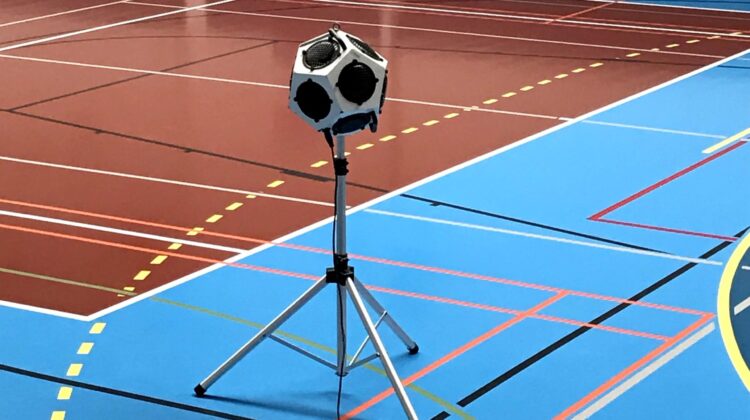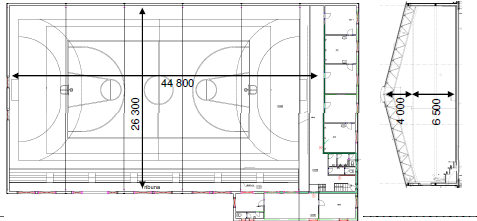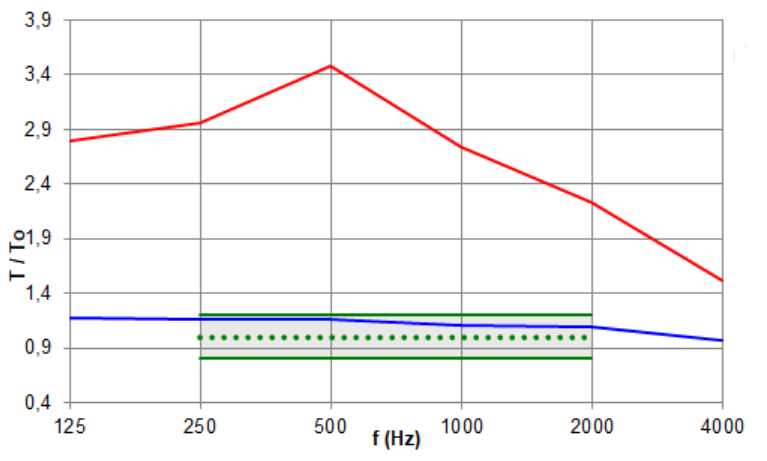
Velka Bystrice is a small town in the Czech Republic with only 3,500 inhabitants. The sports hall is the only facility of its kind in the town. It is an integral part of the life of those living here and is used daily, including weekends.
Description of the case
The area of the hall is 1 180 m2 and the volume is 10 224 m3. The floor is made of a modern rubber surface, the walls are plastered and the roof is composed of sandwich panels. There is a stand with 2 rows of seating along one wall.

According to the mayor of Velka Bystrice Marek Pazdera, the sports hall forms an integral aspect of the town.
“The sports hall was built in 2006. We decided to invest in this project because there was a need to have a municipal sports hall which can serve for PE school lessons, as well as for after school clubs activities and for different local sports associations trainings.”
Meeting Czech acoustic legislation
The standard ČSN 73 0527 (Acoustics-Acoustical design of rooms – Rooms for cultural uses – Rooms in schools – Rooms for public purposes) sets RT values from 250 to 2000 Hz for sports hall according to the volume of the room. The standard requirements must be fulfilled by all newly built and reconstructed buildings.
Compliance with the legislation is controlled by the authority of Ministry of Health called “Hygienic station“. Originally there was an unfortunate mistake by the control authority and the building was approved for operation despite the missing acoustic treatment.
The mayor further commented:
“Over time when the space was being used it turned out that teachers and trainers were not heard properly. Pupils and students could not understand speech well. There were too long reverberations. I got many complaints about the acoustics from visitors, so I decided to find a solution and changed the acoustic comfort in the hall, which meant further investment.“
Measuring the reverberation time
All measurements were done by a neutral third party acoustic consultant, Akusting. The intermittent noise method was applied in accordance with ČSN EN ISO 3382-2 and reverberation values measured originally were extremely high across all frequency bands.

The table below shows the RT values before and after renovation. This hall was far below standard, with values ranging from 4,35-6.78 seconds in the 250 to 2000 Hz range. The target RT depends on the room volume and the optimal value should be 1,95s. Much work was needed to bring these values down into the optimal range.

The tolerance range of RT ratio is marked in green in the graph below. The red line shows the original situation which is far away from the tolerance values. The new status is marked in blue. The reverberation time is in balance now and in accordance with the ČSN 73 0527.

Improving the acoustics with sound absorption
Sound absorbing materials were the only solution. The acoustic absorber Super G Plus was chosen for this space because if its impact resistant properties. The panels had to be installed in rows because of trusses in the ceiling. The rest of the ceiling was covered with plasterboard to create a unified surface.
It is important to remember that this was an additional installation, which incurs additional problems such as the need to closing the space for the duration of the reconstruction and protect surfaces such as the floor in order to avoid damages. Such inconveniences are typical for situations demanding additional acoustic treatments after the building process is already complete, which is why it is better to do it right the first time.
A sound effect on people
The expected noise reduction as a consequence of this treatment is estimated to be about 3,5dB, a halving of the sound energy in the room. A post-occupancy evaluation revealed that the users of this space found the acoustics to be greatly improved. Below are images of the sports-hall before and after renovation.


If you have any questions about this case study or would like to learn more about the solutions, please contact our Concept Developer in Czech Republic, Iveta Kralova at [email protected].

